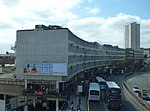The Electric, Birmingham

The Electric is a cinema in Birmingham, England. It opened in Station Street in 1909, showing its first silent film on 27 December of that year. It was the first cinema in Birmingham, and as of 2022 is the oldest known working cinema in the country. The Electric has two screens, both able to show digitally-shot films and one also able to show films in 35 mm.Originally called the Electric Theatre, the cinema has undergone a number of name changes since its opening, but returned as The Electric in October 1993. It closed in December 2003 and was purchased by local film director and producer Tom Lawes, who initiated extensive renovations to the building in order to restore it to its 1930s Art Deco aesthetic. It reopened in December 2004. The cinema closed again at the start of the COVID-19 pandemic in 2020, with most of its staff being made redundant. In January 2022 the cinema reopened under new ownership.
Excerpt from the Wikipedia article The Electric, Birmingham (License: CC BY-SA 3.0, Authors, Images).The Electric, Birmingham
Station Street, Birmingham Digbeth
Geographical coordinates (GPS) Address External links Nearby Places Show on map
Geographical coordinates (GPS)
| Latitude | Longitude |
|---|---|
| N 52.4766 ° | E -1.8987 ° |
Address
The Electric Cinema
Station Street
B5 4DY Birmingham, Digbeth
England, United Kingdom
Open on Google Maps








